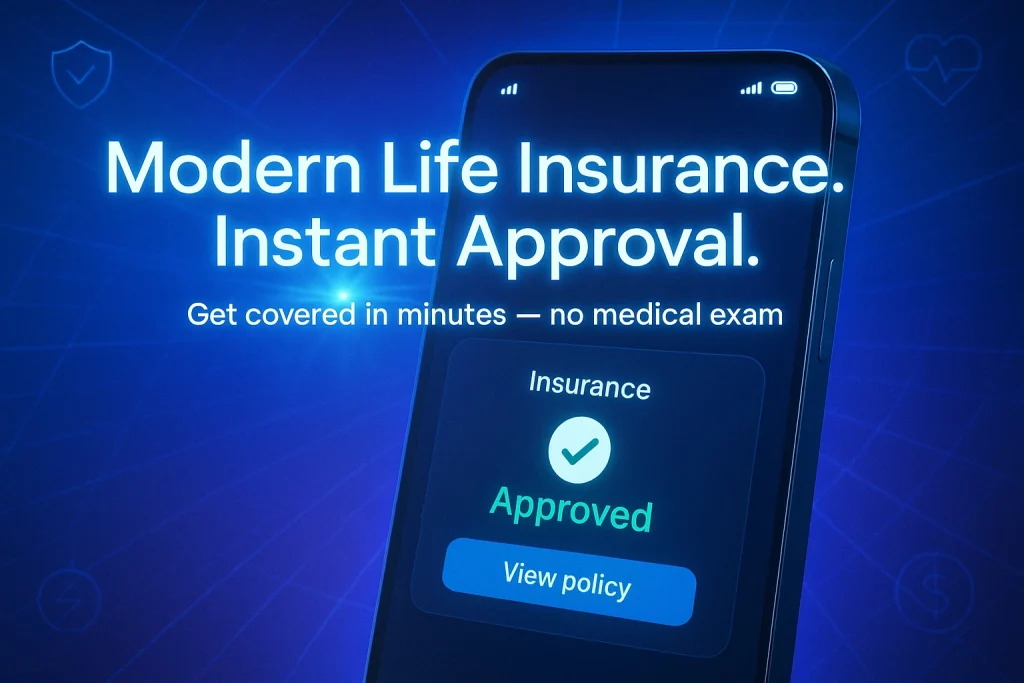Life insurance protects your family’s financial future if something happens to you. By paying small regular premiums, you secure a guaranteed payout known as a death benefit that your loved ones can use for daily expenses, debt payments, college tuition, or funeral costs.
This guide explains how life insurance works, the main types of policies, leading U.S. insurers, and how to pick the right coverage for your budget and goals.
What Is Life Insurance and How Does It Work?
Life insurance is a contract between you, the policyholder, and an insurance company. You agree to pay premiums either monthly or annually, and the insurer promises to pay a death benefit to your chosen beneficiary after you pass away.
Your family can use this money however they need, such as to replace income, pay the mortgage, cover medical bills, or fund a child’s education.
How Life Insurance Works in Simple Terms?
- You apply for a policy and choose a coverage amount, for example, 250,000 or 1 million dollars.
- The insurer reviews your application. Some companies like Ethos or Ladder offer instant approval without medical exams.
- You pay your premiums to keep the policy active.
- When you pass away while the policy is active, your beneficiaries receive a lump-sum payment, usually tax free.
Why Life Insurance Matters for Families?
Life insurance is a safety net. It keeps your loved ones financially stable even after you are gone. It prevents them from selling property, draining savings, or taking loans just to cover bills. It is not about preparing for death but about protecting life and security for those who matter most.

A Quick Overview at the History of Life Insurance
The Early Beginnings
Life insurance has existed for centuries. In ancient Rome, “burial clubs” collected funds from members to pay for funeral costs. These early systems inspired the idea of shared protection that modern insurance is built on today.
The First Life Insurance Companies
The first official life insurance company, the Amicable Society for a Perpetual Assurance Office, was founded in London in 1706. By the mid-1700s, mathematicians had developed life tables to price risk accurately, creating the scientific foundation for the modern life insurance policy.
The Growth of Life Insurance in the United States
Life insurance arrived in America in the 18th century when church groups created funds to support widows and orphans. Over time, companies such as New York Life and Mutual of Omaha shaped the industry.
Today, modern platforms like Ethos, Ladder, and Fabric by Gerber Life are revolutionizing the life insurance online quote process by offering affordable term life insurance without requiring medical exams.
Main Types of Life Insurance And Term
Different policies fit different needs. Below are the most common life insurance plans available to U.S. consumers today.
Term Life Insurance
Best Term life insurance is the most affordable life insurance policy and the simplest form of coverage and term life insurance is also known as life insurance. It lasts for a set number of years, such as 10, 20, or 30. If you pass away during that term, your beneficiary receives the payout.
Key Features:
- Fixed premiums for the duration of the policy
- No cash value, pure protection only
- Policy expires at the end of the term
- Ideal for covering mortgage payments, family income, or childcare costs
Example: A healthy 30-year-old can buy a 20-year 500,000 policy from Ladder or Ethos for around 25 dollars a month.
Best For: Families on a budget or individuals seeking short-term coverage.
Whole Life Insurance
Whole life insurance provides lifetime coverage and includes a savings feature called cash value.
Key Features:
- Lifetime protection guaranteed
- Fixed premiums that never rise
- Cash value grows over time and can be borrowed against
- May include dividends depending on the insurer
Example: Fabric by Gerber Life and CoreBridge Direct offer easy online applications for whole life plans, often with no medical exam required.
Best For: Long-term planners, parents building legacy wealth, and anyone who wants guaranteed lifelong protection.

Universal Life Insurance
Universal life insurance combines lifelong protection with flexibility. You can adjust premiums and coverage as your financial situation changes.
Key Features:
- Flexible premiums and death benefits
- Cash value that grows based on interest rates or inveshttps://fexoi.com/finance/the-right-final-expense-policy/tments
- Ability to modify the policy without starting over
Example: Forbes Life Insurance powered by Ethos offers flexible coverage that allows you to adjust your policy online as your needs change.
Best For: Freelancers or professionals with fluctuating incomes who want control over payments and long-term benefits.
Guaranteed and Final Expense Life Insurance
Guaranteed life insurance is designed for older adults or those with medical conditions. It is also known as final expense insurance.
Key Features:
- Guaranteed approval for most applicants
- Fixed premiums that do not increase with age
- Smaller coverage amounts (5,000 to 50,000 dollars)
- Used mainly for funeral costs and final bills
Example: Ethos and SelectQuote both offer guaranteed acceptance plans that require no medical exam and provide fast approval online.
Best For: Seniors who want peace of mind and coverage for end-of-life expenses.
Group Life Insurance
Group life insurance is typically offered through an employer. It is an easy and low-cost way to start coverage but often limited in amount.
Key Features:
- Coverage offered as part of employee benefits
- No medical exam required
- Ends when employment ends unless converted
- Often one to two times annual salary
Best For: Employees who need basic coverage and plan to supplement with individual policies.
Joint and Family Life Insurance
Joint life insurance covers two people under one policy, often couples or parents with children.
Key Features:
- One policy covers both partners
- Costs less than buying two separate policies
- Can pay out on the first or second death depending on the setup
Example: CoreBridge Direct and SelectQuote allow you to add spousal or child riders for comprehensive family protection.
Other Types of Specialized Life Insurance
Modern insurers offer additional options tailored to specific goals.
- Mortgage Life Insurance: Pays off your home if you die before the loan is paid.
- Accidental Death Insurance: Provides extra payment for accidental deaths.
- Supplemental Life Insurance: Adds extra coverage to group plans.
- Pre-Need Insurance: Pays funeral costs directly to a funeral home.
These options can usually be added to your main policy when buying through digital companies like Ethos or Fabric.

How to Choose the Best Life Insurance Policy?
Set Your Financial Goals
Before comparing life insurance companies, decide why you need coverage.
Are you protecting your family’s income, paying off a mortgage, or leaving an inheritance?
If your goal is temporary protection, term life insurance is ideal. For lifelong coverage, whole or universal life insurance is a better choice.
Create a Budget
Your monthly premium should feel comfortable and sustainable.
Term life policies are usually the most affordable term life insurance options. For instance, a 35-year-old can buy a 500,000 policy for about 20 dollars per month from Ladder or Ethos.
Compare Coverage Amounts
Many online companies such as Fabric by Gerber Life and CoreBridge Direct let you adjust your coverage anytime. You can start small and increase as your income grows.
Use a life insurance calculator to estimate your needs—most experts recommend coverage worth 10 to 12 times your annual income.
Understand Policy Terms
Always review your life insurance policy carefully.
Pay attention to exclusions, waiting periods, and clauses about suicide or fraud. Knowing the details prevents confusion during claims.
What Affects the Cost of Life Insurance?
Typical Costs by Age and Gender
| Age and Profile | Coverage | Term | Monthly Premium Estimate |
|---|---|---|---|
| 25-year-old male non-smoker | 250,000 | 20 years | 15–20 USD |
| 35-year-old female non-smoker | 500,000 | 20 years | 20–25 USD |
| 45-year-old male smoker | 250,000 | 20 years | 60–90 USD |
| 55-year-old female | 100,000 whole life | Lifetime | 120–180 USD |
Premiums increase as you age, so the sooner you buy, the lower your rates will stay for life.
Why Age and Health Matter
Insurance pricing is based on risk. Healthy people get lower premiums, while smokers or people with chronic illnesses pay more.
Companies like Ethos, Ladder, and Fabric use advanced underwriting that lets you skip exams and get coverage in minutes.
Tips for Getting Affordable Coverage
- Apply while young and healthy
- Avoid tobacco and maintain fitness
- Choose level-term coverage to keep payments fixed
- Pay annually for possible discounts
- Compare rates across several life insurance companies before applying

Benefits of Life Insurance
Protects Your Family’s Future
Life insurance gives your loved ones the financial strength to keep going without your income. It covers rent, tuition, medical bills, and day-to-day costs.
Pays Off Debt
Your life insurance benefit can pay off home loans, credit cards, or other debts, ensuring your family keeps their home and stability.
Supports Business Planning
Business owners can use life insurance to protect partners, secure loans, or fund buy-sell agreements.
Offers Tax Free Benefits
In most U.S. cases, death benefits are tax free, which means your family receives the full payout.
Builds Cash Value
Whole life and universal policies accumulate savings over time, which you can borrow against in emergencies or use for retirement planning.
Common Misunderstandings About Life Insurance
“I’m Too Young to Need It.”
Getting coverage early saves thousands of dollars over your lifetime. Young applicants qualify easily and pay the lowest rates.
“My Job Provides Enough Coverage.”
Employer-provided group life insurance rarely exceeds two times your salary and ends when you leave your job. Individual policies offer better long-term security.
“Life Insurance Is Too Expensive.”
Most Americans overestimate the cost. In truth, the cheapest life policy can cost less than one restaurant meal a month.
“Health Issues Mean I Can’t Qualify.”
Modern companies like Ethos and SelectQuote provide simplified or guaranteed life insurance, making it accessible for almost everyone.
Best Life Insurance Companies in the U.S. (Forbes Rankings)
Forbes evaluated hundreds of insurers and selected the top six based on affordability, customer service, and innovation.
| Rank | Company | Coverage Range | Key Features | Rating | Best For |
|---|---|---|---|---|---|
| 1 | Ethos | 25,000 to 3 million | Fully online, no exams, instant coverage, plans from 9 USD per month | 9.8 Excellent | Busy families and new buyers |
| 2 | Ladder | 100,000 to 3 million | Adjustable coverage, cancel anytime, no policy fees | 9.7 Excellent | Professionals seeking flexibility |
| 3 | Forbes Life Insurance powered by Ethos | Up to 3 million | Compare top carriers in 10 minutes, lowest rate guarantee | 9.5 Very Good | Shoppers comparing multiple rates |
| 4 | Fabric by Gerber Life | Up to 1.5 million | Instant approval, family-friendly mobile app, no medical exam | 9.5 Very Good | Young parents and families |
| 5 | SelectQuote | Up to 500,000 average | Compare top carriers with agent support | 9.2 Very Good | Buyers wanting expert advice |
| 6 | CoreBridge Direct | 250,000 to 1 million | Affordable plans, online applications, flexible options | 9.1 Very Good | Budget-focused planners |
These companies combine affordable term life insurance, flexible coverage, and modern digital convenience, giving Americans reliable protection with quick approvals.
Key Lessons from the Forbes Rankings
- Instant Approval: Companies like Ethos and Ladder eliminate medical exams for most healthy applicants.
- Flexible Coverage: Ladder and CoreBridge Direct let users adjust coverage easily.
- Transparent Pricing: Real-time quotes ensure there are no hidden costs.
- Customer Trust: All six companies hold strong financial ratings and excellent customer reviews.
- Accessibility: Policies start around 9 to 15 dollars per month for 100,000 to 250,000 in coverage.
When choosing your policy, verify each company’s financial strength through AM Best or similar rating agencies.
FAQs
1. What is term life insurance?
It provides protection for a set number of years. If you pass away during that period, your beneficiary receives the payout.
2. What is the life insurance?
It is a financial contract where you pay premiums, and your insurer pays a death benefit to your family.
3. Is life insurance taxable?
No. Death benefits are usually tax free for your beneficiaries in the U.S.
4. What is whole life insurance?
A permanent policy that provides lifetime coverage and builds cash value over time.
5. How does life insurance work?
You apply, pay premiums, and your loved ones receive a payout after your death.
6. How much life insurance do I need?
Most experts suggest 10 to 12 times your annual income plus any major debts.
7. How much does life insurance cost?
It depends on your age, health, and policy type. Term life plans often start below 20 dollars a month.
8. What is universal life insurance?
A flexible permanent policy that lets you adjust premiums and benefits.
9. Does life insurance cover suicidal death?
Yes, after the first two years of the policy in most cases.
10. What is voluntary life insurance?
An optional employer-provided policy that you can choose and pay for yourself.
11. Can you have multiple life insurance policies?
Yes. You can hold multiple policies as long as the combined coverage makes sense for your income.
12. Can you get life insurance if you have cancer?
Some guaranteed or simplified issue plans, such as those from Ethos or SelectQuote, may accept you depending on your condition.
13. Can you take out life insurance on anyone?
No. You must have an insurable interest such as a family or business relationship.
14. How many life insurance policies can I have?
There is no legal limit, but insurers evaluate total coverage to prevent over-insurance.
Final Thoughts
Life insurance is more than a policy. It is a promise that your family’s future will remain stable even if life takes an unexpected turn.
Whether you prefer a simple term plan from Ethos or Ladder, a flexible option from CoreBridge Direct, or a family-oriented policy from Fabric by Gerber Life, the best time to buy is now.
The younger and healthier you are, the more affordable your policy will be. Take the time to compare options, read the terms carefully, and choose coverage that fits your life, budget, and goals.
With the right policy in place, you can rest easy knowing that the people you love will always be protected.







